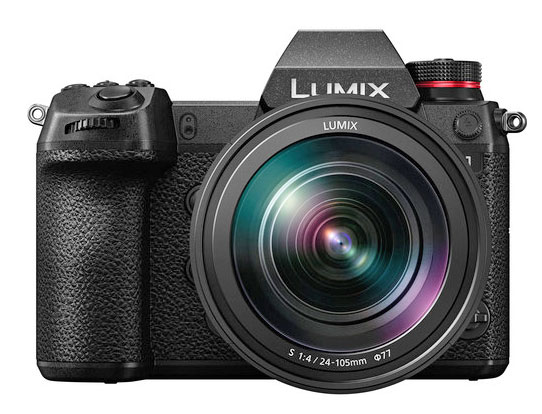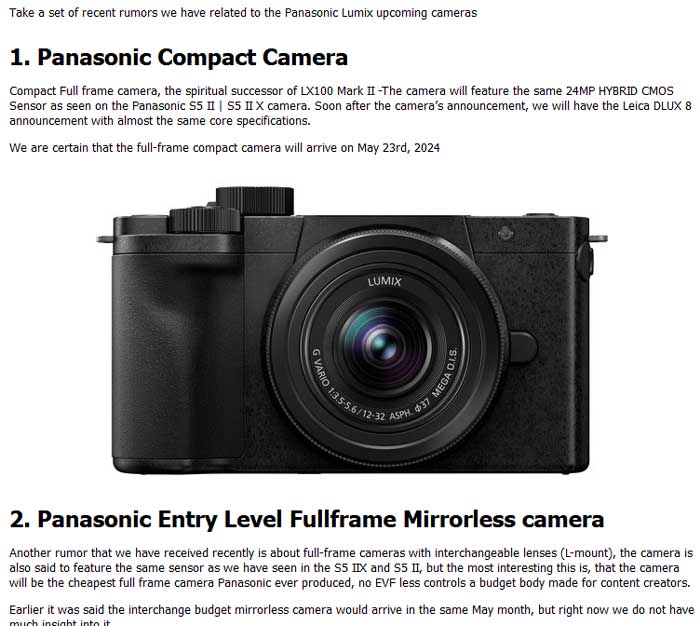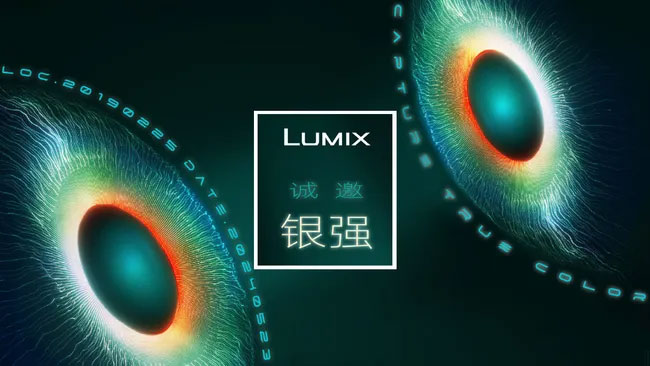Join More Than 50,000+ Subscribers and get latest camera news and rumors
NEW CAMERA VIDEOS ON YOUTUBE
|
By admin, on June 14th, 2024

According to the latest rumors surfaced over the web, after the Pansonic GH7 update now Panasonic will revive the “S” series of full-frame cameras. The Panasonic S1H Mark II is said to be one of the announcement pipelines, expected to arrive in Q4 of 2024. published on June 9, 2024
We have published this post back on June 9, 2024. Now the same information appears on camera-beta (webio). So, either they have their source of just they are copying us I am not able to tell this, but since their post have no mentions or credits to anyone we are considering it as a fresh piece of information that exactly resembles the info we have shared a while ago.
information shared by Camera beta today – June 14, 2024
Panasonic Lumix S1H II may be released in the fourth quarter – According to the latest information, after the release of Panasonic GH7, the next update will be for the S series full-frame camera bodies. According to previous rumors, Lumix S1H II is among them, and it is expected to be officially released within this year (fourth quarter).
Follow us on our social pages FACEBOOK | TWITTER | INSTAGRAM, to get LIVE News and Panasonic Rumor
source camerabeta
By admin, on June 9th, 2024

According to the latest rumors surfaced over the web, after the Pansonic GH7 update now Panasonic will revive the “S” series of full-frame cameras. The Panasonic S1H Mark II is said to be one of the announcement pipelines, expected to arrive in Q4 of 2024.
Follow us on our social pages FACEBOOK | TWITTER | INSTAGRAM, to get LIVE News and Panasonic Rumor
By admin, on June 6th, 2024

Panasonic GH7 Press Release
Panasonic is proud to introduce the new LUMIX GH7 – the latest flagship model of the Micro Four Thirds mirrorless LUMIX G Series.
The LUMIX GH7 delivers outstanding video performance, wide dynamic range with a newly developed 25.2MP BSI CMOS sensor and improved AF performance with PDAF (Phase Detection Auto-Focus). To support the efficient workflow required in professional production environments, it is now newly equipped with Apple ProRes RAW*1 internal recording and a World’s first 32-bit float recording*2, which eliminates the need to adjust sound recording levels during shooting.
With the rapid increase in demand for video content in recent years, the number of small teams of video creators is increasing along with the demand for further improvement in the quality of mirrorless cameras with excellent video performance and portability. Since its release in 2009, our LUMIX GH series has developed a strong reputation among creators and video production teams, as a model renowned for its shooting performance, innovative features and reliability.
The LUMIX GH7 is a next-generation mirrorless camera that meets the needs of creators, whatever their creative field may be.
Main Features
- High performance, fast response, and excellent mobility
- 25.2MP BSI CMOS sensor with high resolution and fast response, along with 13+ stop dynamic range boost*3 with rich gradation
- Adopting PDAF for high-speed, high-precision AF performance, and newly added real-time auto-focus recognition AF for airplane and train
- Improved image stabilization technology, including perspective distortion correction for videos and High mode in Active I.S. to enable powerful compensation when shooting on the move
- Enhanced video quality and optimized workflows from shooting to post-production
- Internal recording of 5.7K 30p ProRes 422 HQ and ProRes RAW HQ*1.
- World’s first 32-bit float recording*2, eliminating the need to adjust audio recording levels during shooting when using the new XLR microphone adaptr, DMW-XLR2 (sold separately).
- Allows users to load original LUT files and apply new color looks directly to videos and photos with REAL TIME LUT.
- Enables proxy recording for workflow efficiency and supports native Camera to Cloud integration with Adobe’s Frame.io enabling images and videos to be automatically uploaded, backed up, shared, and worked on jointly via the cloud.
- Open Gate recording to enable flexible framing for any social media platform or client needs.
- Reliable in the video production field
- Unlimited video recording made possible with efficient heat dissipation processing and the integration of a cooling fan*4.
- Convenient tilt-free angle monitor that does not interfere with HDMI or USB cables when tilted
- Able to withstand harsh environments with dust, splash resistance*5, and freeze-resistance down to -10 degrees Celsius/14 degrees Fahrenheit.
By admin, on June 2nd, 2024
We are getting strong information from the past month that Panasonic has strong plans to announce not one but a total of 3 cameras,
March 11, 2024 [check post here] – Panasonic Registers 3 NEW cameras, one of them is said to be Panasonic GH7 according to E8M_8888
Update: The total number of unreleased models are P2303A, P2302A, and P2304A.
One of them is also considered to be Panasonic GH7 [told in March 11]
On May 8, Way before other Rumor Mills We told you, to check the post here

Before May 8, we got Strong Hints that Panasonic was about to announce two cameras, We have written in our post that DAY
Interestingly, two Cameras from Pansonic are coming Soon. it’s hard to believe that Panasonic has two new cameras with FF sensors coming soon, yes we do have information in the past that the compact camera will have an FF sensor but one more Entry Level Mirrorless is also coming, this particular news makes me very excited
you can check these lines in the article
Again on May 11, 2024
[ check post here ] We have received strong hints about Panasonic TWO’s new camera arriving, but we have been confused with the information provided by the source and considered the compact camera will have a Fullframne Sensor, actually, now we know the Compact has a M4/3 Sensor

At the time of the Panasonic S9 Announcement, A user asked me


Summary, 1 Announced two more to go
After the Panasonic S9 announcement, However, we still have two more announcements from Panasonic shortly one compact and another of Panasonic GH7.
Follow us on our social pages FACEBOOK | TWITTER | INSTAGRAM, to get LIVE News and Panasonic Rumor
By admin, on May 20th, 2024

According to the latest rumors we have the Panasonic Lumix S9 Mirrorless camera will be announced on May 22, 2024, the price of the camera is said to be $1499 along with the kit lens, take a look at the set of leaked specifications of the upcoming camera
The Panasonic S9 Core specification
- It features a lightweight body that leans towards video production.
- The compact body does not have an EVF and is smaller than the Fuji X100 VI.
- Equipped with the same 24 million pixel sensor as the Panasonic Lumix S5 II.
- 779-Point Phase-Detection AF System
- 6K30p 4:2:0 10-Bit Video Recording
- C4K/4K60p 4:2:2 10-Bit
- The body comes with a dedicated LUT button and allows for uploading custom LUTs.
- It has in-body image stabilization.
- Features a flip touch screen.
- There is no mechanical shutter.
- The camera is available in various colors such as black, green, blue, and red.
- Priced $1499
I believe that in the future, Panasonic will continue to release more compact and lightweight lenses suitable for this entry-level full-frame mirrorless camera.
Follow us on our social pages FACEBOOK | TWITTER | INSTAGRAM, to get LIVE News and Panasonic Rumor
source L rumor
By admin, on May 13th, 2024

According to the latest rumors surfaced over the web, the new Panasonic camera has been confirmed as the LUMIX S9. It will be released on May 22/23 (depending on the local time difference). This entry-level, interchangeable lens full-frame camera focuses on video capabilities. It has a dedicated LUT button that allows users to switch between different LUT filter effects (similar to the film simulation switch knob on the Fuji XT50) and supports custom LUTs. It is equipped with the same 24 million pixel CMOS sensor as the Panasonic S5 II / S5 IIX, does not have an electronic viewfinder, is smaller than the Fuji X100VI camera, and comes in four different body colors.
stay tuned more updates coming
Follow us on our social pages FACEBOOK | TWITTER | INSTAGRAM, to get LIVE News and Panasonic Rumor
source – webio
By admin, on May 13th, 2024
 Panasonic teaser image of the upcoming full frame compact camera With the tagline of the “totally unexpected” camera coming on May 23, Panasonic is teasing the announcement of a new Lumix camera.

Well, that is not new to you guys, we have mentioned several times in the past week that Panasonic is about to release a new full-frame compact camera, and soon after that, camera core specs and a re-branded body the Leica Dlux 8. We also have rumors related to a Panasonic entry-level full-frame mirrorless camera with an L-mount.
See more
List of Upcoming Cameras and Lenses May 2024
Panasonic Lumix Announcement on May 23rd, 2024
Entry Level FullFrame Camera From Panasonic Coming Soon
Follow us on our social pages FACEBOOK | TWITTER | INSTAGRAM, to get LIVE News and Panasonic Rumor
|
KEEP THIS BLOG ALIVE - Support New Camera Buy Canon Lenses, Buy Music CD or Digital Camera at amazon it helps this site, and you do not pay anything extra, it is just a way to help support this site.

|


















